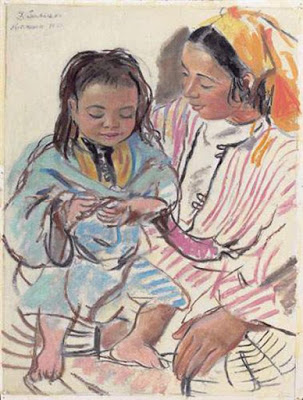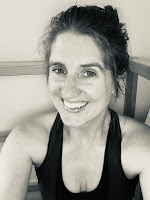by Sarah Blunkosky

| Mother and Daughter by Zinaida Serebriakova |
I am the mother of and full-time caregiver for three children ages 14, 10, and 8. The oldest has both Down syndrome and autism. My yoga for caregiving is centered in purpose, without attachment to outcome. I try to dwell in what needs to be done. My yoga permeates in the preparing of food, the giving of loving hugs, the cleaning of soiled sheets. My yoga is:
- The self-giving care
- The person cared for
- The universe upholding those cared for
So my yoga becomes a practice for all.
I often come to this verse from the Bhagavad Gita translated by Vedanta scholar and yoga teacher Swami Venkatesananda:
III/19. Therefore, without attachment do thou always
perform action which should be done (your duty). For, by
performing action without attachment man reaches the supreme.
Especially for my eldest daughter, Josie, I am not attached to her taking care of me in return one day. Likely, because I do not depend on the eldest to care for me one day, I also do not expect any of my children to care for me. Perhaps this is from losing my mother at sixteen and not seeing filial piety in action for elder care. I’ll be grateful for whatever (if anything) is offered later in life, but the expectation is not currently planted in my future. I also do not expect my children to fulfill my dreams for me. I wanted each of them, fiercely, and my sole intentions for them are to assist their journeys as long as they need me.
I am aligned with the giving of care. I am aligned with the giving of compassion. My intention is ahimsa (non-harm). When I occasionally rage inside or host a bit of an inner rebellion, I try to go on a long walk, car ride, or hike in the woods.
The muck—the fear, the stress, the cascading blood pressure, stifled breath—all arise in the caregiving day. Caregiving for a loved one, young or old, especially those with significant and complex medical conditions, one often sits with fear of loss, each day, often for several instances and moments.
During this pandemic fear greets me frequently when I sit on and off of my yoga mat. I do not know if my eldest daughter will survive if she falls ill from COVID-19. She’s had three hospitalizations for viral-induced pneumonias in her fourteen years of life, and I do not know how she will process COVID-19. I also do not know how my son’s severe asthma will show up with COVID-19. I myself have asthma and psoriatic arthritis, so my own health and interaction with this pandemic world does not feel optimum.
When I feel anxious or unsettled, active asana practice moves the energy a bit, tries to ground anxiety into steadier roots, and sometimes removes stuck-ness, like unclogging a drain, getting gears moving the machine of body, mind, spirit, reconnecting those train cars and have ‘em greasing rails again. I like gentle and loving sequences, such as these:
- Tadasana (Mountain pose), coming into Utkatasana (Chair pose), and then sometimes wiggling and shifting into Malasana (Garland pose)
- Marjaryasana (Cat), Bitilasana (Cow), and then Balasana (Child’s pose)
So much goes into caring that my asana practice is often taking a few powerful asanas and really trying to enjoy the yumminess of each posture and the transition into each. As my dear friend Amy taught me, “Each transition is also a pose.”
Viparita Karani (Legs Up the Wall pose). This is often where I try to throw myself spiritually up there, feeling a bit ragdoll like, half in submission and rest, and half trying to hold parts of myself up that often hide or feel subverted in the ebb and flow of the day. If I rush too fast into it, I can strain or feel blah. If I really breathe and ease gently, laying down, then doing the gentle scooching my glutes and comfortably slide-turning my legs up to the wall, then the asana becomes one of relief. I especially adore clearing my sinuses and feeling a soothing rush of tingling prana in my head and the lymphatic draining in my legs is yoga joy.
Savasana (Corpse pose). This is where the bones and organs get to sink and drop, my kidneys tingle, and prana trickles around the vital organs, oiling gears and offering nutrients for the next day.
Often caregiver poses are the ones where I shift between finding strength, submitting to God/universe/infinite connection of time and space, and finding inquiry in the pause where my mind, breath, and body can stop going in weirdly diagonal directions of energy paths cascading intertangled, but come back together, x marking the spot where integration happens.
I sit with breath. The basic and most profound pranayama practices are still where I often struggle and are some of my greatest places to work. I start with sending my focus to the breath (I lose it often in other focuses—paying the bills, doing the dishes, letting the barking dog out the back door) and trying to spend more time with the breath, open to this truth that with greater awareness of my breathing, I find greater focus in my mind and connection to my body. So sometimes I start with:
- Listening to my breath.
- Feeling my breath move into my nostrils, mouth, and parts of my chest.
- Asking if my breath is going deeper into my back lungs or feeling shallower, caught in this feeling like I can’t complete a yawn (this is always a source of stress or pause for me).
If my breath is not feeling at ease, I try to bring greater ease to it in one or several practices:
- I breathe deep into the back lungs/rib areas.
- I lift up my arms and side bend over to the opposite side, then breathe into the lung tissue under the armpit, taking turns on each side.
- I sit or stand against a wall, close my eyes, and try to breathe, feeling supported and safe against the sturdiness of the wall and calmer with less sensory stimulation to my eyes.
- I extend my exhalation, making my exhalation twice as long as my inhalation by breathing in for, say, a count of 3, then exhaling for, say, a count of 6. Then I gradually lengthen my exhalation even more in the hopes of slowing any racing-ness of my heart from stress.
I have also found that adapting my meditation practice to sit with fear, adopting many principles and instructions from the Tibetan Buddhist practice of Tonglen meditation, welcoming the suffering in, breathing out more love into the world, has been a center in constant whirlpool of shifts, waves of politics and noise whizzing by, and mothering to do.
My practice is in constant change, recognizing impermanence, trying to hold onto love and compassion, and let go of everything else, because the grasping is too tiring and the strife weighs in my heart. It’s messy and dusty and sneezy—the fluctuation and muddle. Always, within, I find infinite gratitude.

Sarah Blunkosky, M.A., 200 E-RYT, RYT 500, RPYT, RCYT is an integrative education consultant, certified peer-breastfeeding counselor, and registered Accessible Yoga instructor specializing in family, children’s, special-needs, and prenatal/postpartum movement/embodiment. Her learning life spanned teaching high school social studies at Open High School in Richmond, Virginia to studying slavery and social history on a graduate school path that pivoted when her eldest daughter’s intellectual disabilities and medical needs required an intensive lifestyle shift. She started Learning Heroine LLC in 2015. You can find her on Instagram and Facebook sharing her dharma/mission: Set learning free. When she isn’t homeschooling her kids or teaching yoga, you can find her writing articles and working on a book. A forever student of yoga, she is also studying to become a certified yoga therapist.
Follow Yoga for Healthy Aging on Facebook ° To order Yoga for Healthy Aging: A Guide to Lifelong Well-Being, go to Amazon, Shambhala, Indie Bound or your local bookstore.


Sarah, This is a perfect Thanksgiving offering. I plan on reading to my class this evening during their savasana. So much wisdom and gratitude.
So honored to serve:) Much compassion and love for your journey!
Many Thanks for this most eloquent and genuine post. Most healing thing I’ve read since feeling inadequate in a series of caregiving situations over last 10 years.
Many Thanks for this healing message. Eased my sense of inadequacy in the caregiving role.
This post speaks to my own experience of parenting. “I wanted each of them, fiercely, and my sole intentions for them are to assist their journeys as long as they need me.” Love.